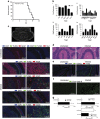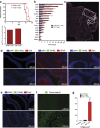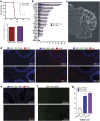CD4 and CD8 T cells mediate distinct lethal meningoencephalitis in mice challenged with Tacaribe arenavirus
- PMID: 27569560
- PMCID: PMC5214944
- DOI: 10.1038/cmi.2016.41
CD4 and CD8 T cells mediate distinct lethal meningoencephalitis in mice challenged with Tacaribe arenavirus
Abstract
Neonates are at increased risk of viral encephalopathies that can result in neurological dysfunction, seizures, permanent disability and even death. The neurological damage results from the combined effect of the virus and the immune response it elicits, thus finding tools to facilitate viral clearance from central nervous system (CNS) while minimizing neuron damage remains a critical challenge. Neonatal mice inoculated intraperitoneally with Tacaribe virus (TCRV) develop seizures, hindlimb paralysis and death within 15 days of inoculation. TCRV localizes to the CNS within days of challenge, primarily infecting astrocytes in the cerebellum and brain stem. We show that infection leads to inflammation, T cell and monocyte infiltration into the cerebellar parenchyma, apoptosis of astrocytes, neuronal degeneration and loss of Purkinje cells. Infiltrating antigen-specific T cells fail to clear the virus but drive the disease, as T-cell-deficient CD3ɛ KO mice survive TCRV infection with minimal inflammation or clinical manifestations despite no difference in CNS viral loads in comparison with T-cell sufficient mice. CD8+ T cells drive the pathology, which even in the absence of CD4+ T-cell help, infiltrate the parenchyma and mediate the apoptotic loss of cerebellar astrocytes, neurodegeneration and loss of Purkinje cells resulting in loss of balance, paralysis and death. CD4+ T cells are also pathogenic inducing gliosis and inflammation in the cerebellum and cerebrum that are associated with wasting and death several weeks after CD4+ T-cell transfer. These data demonstrate distinct pathogenic effects of CD4+ and CD8+ T cells and identify them as possible therapeutic targets.
Figures







Similar articles
-
CD4+ T Cells Orchestrate Lethal Immune Pathology despite Fungal Clearance during Cryptococcus neoformans Meningoencephalitis.mBio. 2017 Nov 21;8(6):e01415-17. doi: 10.1128/mBio.01415-17. mBio. 2017. PMID: 29162707 Free PMC article.
-
CpG oligodeoxynucleotides protect newborn mice from a lethal challenge with the neurotropic Tacaribe arenavirus.J Immunol. 2006 Apr 15;176(8):4940-9. doi: 10.4049/jimmunol.176.8.4940. J Immunol. 2006. PMID: 16585590
-
Clearance of an immunosuppressive virus from the CNS coincides with immune reanimation and diversification.Virol J. 2007 Jun 6;4:53. doi: 10.1186/1743-422X-4-53. Virol J. 2007. PMID: 17553158 Free PMC article.
-
Apoptosis during arenavirus infection: mechanisms and evasion strategies.Microbes Infect. 2018 Feb;20(2):65-80. doi: 10.1016/j.micinf.2017.10.002. Epub 2017 Oct 28. Microbes Infect. 2018. PMID: 29081359 Review.
-
Arenavirus evasion of host anti-viral responses.Viruses. 2012 Oct 17;4(10):2182-96. doi: 10.3390/v4102182. Viruses. 2012. PMID: 23202459 Free PMC article. Review.
Cited by
-
Long-term persistence of infectious Zika virus: Inflammation and behavioral sequela in mice.PLoS Pathog. 2020 Dec 10;16(12):e1008689. doi: 10.1371/journal.ppat.1008689. eCollection 2020 Dec. PLoS Pathog. 2020. PMID: 33301527 Free PMC article.
-
PD1+CCR2+CD8+ T Cells Infiltrate the Central Nervous System during Acute Japanese Encephalitis Virus Infection.Virol Sin. 2019 Oct;34(5):538-548. doi: 10.1007/s12250-019-00134-z. Epub 2019 Jun 18. Virol Sin. 2019. PMID: 31215000 Free PMC article.
-
Differential Immune Responses to New World and Old World Mammalian Arenaviruses.Int J Mol Sci. 2017 May 12;18(5):1040. doi: 10.3390/ijms18051040. Int J Mol Sci. 2017. PMID: 28498311 Free PMC article. Review.
-
Innate immunity and inflammation.Cell Mol Immunol. 2017 Jan;14(1):1-3. doi: 10.1038/cmi.2016.45. Epub 2016 Aug 22. Cell Mol Immunol. 2017. PMID: 27545072 Free PMC article. No abstract available.
-
Zika virus-induced acute myelitis and motor deficits in adult interferon αβ/γ receptor knockout mice.J Neurovirol. 2018 Jun;24(3):273-290. doi: 10.1007/s13365-017-0595-z. Epub 2018 Feb 23. J Neurovirol. 2018. PMID: 29476408 Free PMC article.
References
-
- Bowen M, Peters CJ, Nichol ST. The phylogeny of New World (Tacaribe complex) arenaviruses. Virology 1996; 219: 285–290. - PubMed
-
- Salvato MS, Charrel RN, Clegg JCS, Buchmeier MJ, Gonzalez JP, Lukashevich IS et alFamily arenaviridae. In: Regenmortel MHV, van Fauquet CM, Bishop CM (eds). Virus Taxonomy, 8th edn. Academic Press: Orlando. 2004, pp 633–640.
-
- Martinez-Peralta LA, Coto CE, Weissenbacher MC. The Tacaribe complex—the close relationship between a pathogenic (Junin) and a nonpathogenic (Tacaribe) arenavirus. In: Salvato M (ed.) The Arenaviridae, 1st edn. Plenun Press: New York. 1993, pp 281–298.
-
- Charrel RN, de Lamballerie X. Arenaviruses other than Lassa virus. Antiviral Res 2003; 57: 89–100. - PubMed
Publication types
MeSH terms
LinkOut - more resources
Full Text Sources
Other Literature Sources
Research Materials

